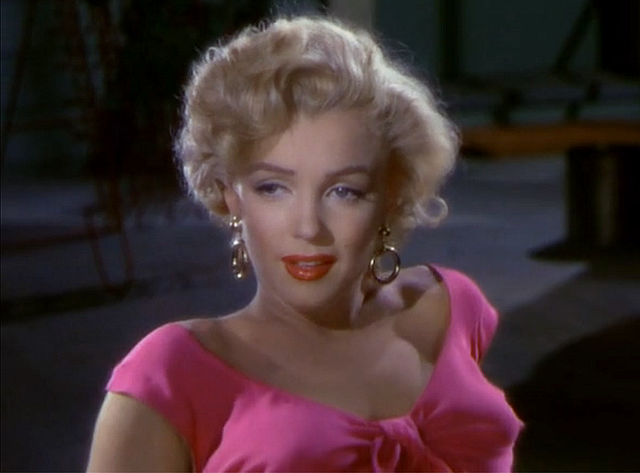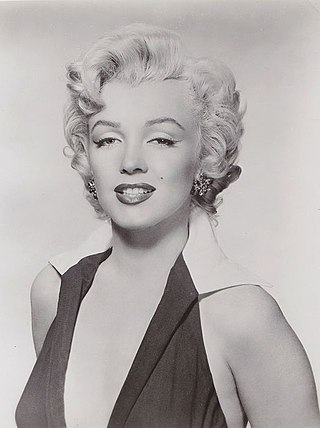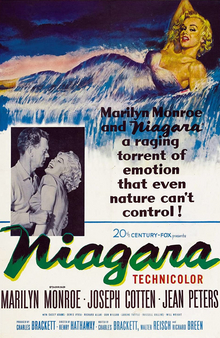Top Qs
Timeline
Chat
Perspective
Niagara (1953 film)
1953 film by Henry Hathaway From Wikipedia, the free encyclopedia
Remove ads
Niagara is a 1953 American noir[3][4] thriller film[5] directed by Henry Hathaway, produced by Charles Brackett, and written by Brackett, Richard L. Breen and Walter Reisch. The film stars Marilyn Monroe, Joseph Cotten, Jean Peters, and Max Showalter (credited as Casey Adams). It was one of 20th Century Fox's biggest box-office hits that year.
Remove ads
Unlike other films noir of the time, which were typically black-and-white,[3] Niagara was filmed in "three-strip" Technicolor (one of the last films to be made at Fox in that format, as a few months later Fox began converting to CinemaScope, which had compatibility problems with three-strip but not with Eastmancolor).
Monroe was given top billing in Niagara, which elevated her to star status. Her next two films, Gentlemen Prefer Blondes (1953) and How to Marry a Millionaire (1953), were even bigger successes.
Remove ads
Plot
Summarize
Perspective

Ray and Polly Cutler, a couple on a delayed honeymoon, arrive at Niagara Falls. Ray goes to call his boss, Mr. Kettering, whom he expected to find waiting for him. However, it appears that Mr. Kettering and his wife have not arrived yet. Meanwhile, Polly finds their reserved cabin occupied by another couple, George and Rose Loomis. When Mr. Qua, the cabin owner, asks Rose to check out, Rose tells them that George is asleep and had been recently been discharged from an Army mental hospital after his service in the Korean War and that she doesn't want to wake him, as he is not quite himself. The Cutlers politely accept another cabin without a view of the Falls, and the two couples become acquainted.
George and Rose have a troubled and volatile marriage. She is younger and seductively attractive. He is jealous, depressed and irritable. While touring the Falls the following day, Polly sees Rose passionately kissing another man, her lover Ted Patrick.
That evening, Rose joins an impromptu outdoor party and requests that a record of her favorite song, "Kiss", be played. George storms out of their cabin and breaks the record, suspecting the song has a secret meaning for Rose. Seeing that George has cut his hand with the record, Polly visits his room to apply mercurochrome and bandages. George confides that he was a sheep rancher whose luck turned for the worse after he married Rose, whom he met when she was a barmaid.

The next day, Rose lures George into following her to the dark tourist tunnel underneath the Falls, where Ted is waiting to kill him. To let Rose know that George is dead, Ted will request the Rainbow Tower Carillon play "Kiss." When she hears the song being played on the carillon bells, Rose assumes that George is dead. However, it is George who has killed Ted, thrown his body into the Falls, and collected Ted's shoes at the exit instead of his own. This leads the police to believe that George is the victim. The body is retrieved and the police bring Rose to identify George's body. When the cover is lifted from the face and she recognizes the dead man, she collapses before saying anything and is admitted to the hospital.
Mr. Qua moves the Cutlers' belongings to the Loomises' cabin. George comes to the cabin seeking revenge on Rose but finds Polly sleeping there instead. She wakes and sees him before he runs away. She tells the police, who launch a dragnet. During the Cutlers' second visit to the Falls, George finds Polly alone for a moment. Trying to escape, she slips, but he saves her from falling over the edge into the waterfall torrent. He explains to her that he killed Ted in self-defense and begs her to "let me stay dead." Polly leaves without answering. Later that day, she tells the police detective that she believes George is alive. George has the carillon play "Kiss" again to panic Rose, who flees the hospital, intending to cross the border back to the United States. Finding George waiting at the border for her, she flees and tries to hide in the carillon bell tower. In a fit of anger, George catches her and strangles her beneath the silent bells. He tries to flee but realizes that he is locked in the building. Realizing what he has done, he sits down next to Rose's body and remorsefully tells her that he loved her. After a trash man unlocks the door, George flees the tower and heads for the Falls.

The Cutlers go fishing with the Ketterings in a launch on a section of the Niagara River above the Falls. When the speedboat moors in Chippawa for gasoline and other supplies, George steals it to try and cross the Canada–United States border, but Polly returns to the boat before he can depart. Seeing George's hat on the table, Polly realizes he is on board. She tries to stop him from leaving, but he shoves her away, and she falls to the ground. Before George can remove Polly from the boat, the boatman sees him on board, so George has no choice but to depart with Polly on board. Polly tells him to give himself up to the police as he killed Ted in self-defense, but he tells her he cannot because he has killed Rose. Polly is horrified. After the boatman reports the stolen boat, the police set out in pursuit.
However, the boat runs out of gas and drifts towards the Falls. The police are unable to help as the boat is too close to the edge. As they near the edge, George scuttles the boat to try and ground it, to no avail. However, this slows it down enough for him to get Polly onto a large rock before he goes over the Falls to his death. A devastated Polly is rescued from the rock by a U.S. Coast Guard helicopter. She and Ray are reunited and leave the Falls together.
Remove ads
Cast
- Marilyn Monroe as Rose Loomis, a scandalous, sexy young woman plotting to murder her husband, George, so she can run away with her lover, Ted
- Joseph Cotten as George Loomis, Rose's older, grumpy husband.
- Jean Peters as Polly Cutler, a kind, observant woman on a three-year delayed honeymoon with her husband, Ray.
- Casey Adams as Ray Cutler, Polly's husband.
- Denis O'Dea as Inspector Starkey, the inspector working on George Loomis's case.
- Richard Allan as Ted Patrick, Rose's secret lover.
- Don Wilson as Mr. Kettering, Ray Cutler's boss.
- Lurene Tuttle as Mrs. Kettering, Mr. Kettering's wife.
- Russell Collins as Mr. Qua, the owner of the hotel the Loomises and Cutlers stay in.
- Will Wright as the boatman who owns the boat the Cutlers and Ketterings use, which is also the boat George Loomis goes over the Falls in.
Remove ads
Production
Summarize
Perspective

Walter Reisch said producer Charles Brackett wanted to make a film set around Niagara Falls and Reisch suggested it be a murder mystery. Reisch said, "Anybody hearing the name Niagara thinks of honeymoon couples and of some sentimental story of a girl walking out on her husband on their wedding night and their getting together again. It would be foolish to start up with Sonja Henie tricks here or Esther Williams-type swimming extravaganzas. I would like to make it a mystery story, with a real murder in it." [6]
Reisch said he came up with the story but wrote the script with Richard Breen and Brackett.[6]
Head of Fox Darryl F. Zanuck wanted to cast Monroe in the film. According to Reisch, "we thought that was a nice idea, until there came a second telephone call that he wanted her to be the villainess, not the girl... My God! Here was the prettiest girl in the whole United States of America! But he insisted it was a great idea, so we finally did it. We didn't know whether she would like it, but she had no objection, whatsoever—on the contrary."[6]
Peters replaced Anne Baxter in the role of Polly. Shooting of Niagara took place from early June to mid-July 1952.[7] Peters' character was initially the leading role, but the film eventually became a vehicle for Monroe, who was by that time more successful.[8]
Reisch says there are "major sequences missing" from the final film. "After he'd seen it, Zanuck simply couldn't accept the fact that the police at Niagara Falls were of Canadian extraction. We had British actors playing Canadian police commissioners and detectives and various cops, and he just abhorred it. He wouldn't let us go back to the stages to finish it or to repair it—no, he just took it out! The American audience, he said, does not know, does not understand, that the Niagara Falls are bisected by the border . . . and we should have used Americans. And [director Henry] Hathaway, who didn't like the idea either, sided with him. So there are big holes in the story."[6]
Henry Hathaway said the film would have been better had his original choice James Mason played the lead male role. He says Mason was going to play the role but his daughter was sick of seeing him die in movies so the actor turned the role down. "Cotten's a good actor but doesn't have the smouldering edge that Mason has; he's a little flat," said Hathaway.[9]
"Kiss" was composed by Lionel Newman, with lyrics by Haven Gillespie—both of whom are uncredited—and performed by Monroe.[10]
Remove ads
Reception
Summarize
Perspective
Critical response
Upon the film's release, A. W. of The New York Times praised the film, if not the acting, writing, "Obviously ignoring the idea that there are Seven Wonders of the World, Twentieth Century-Fox has discovered two more and enhanced them with Technicolor in Niagara... For the producers are making full use of both the grandeur of the Falls and its adjacent areas as well as the grandeur that is Marilyn Monroe... Perhaps Miss Monroe is not the perfect actress at this point. But neither the director nor the gentlemen who handled the cameras appeared to be concerned with this. They have caught every possible curve both in the intimacy of the boudoir and in equally revealing tight dresses. And they have illustrated pretty concretely that she can be seductive—even when she walks. As has been noted, Niagara may not be the place to visit under these circumstances but the falls and Miss Monroe are something to see."[11]

Also in 1953, a reviewer at Variety wrote, "Niagara is a morbid, clichéd expedition into lust and murder. The atmosphere throughout is strained and taxes the nerves with a feeling of impending disaster. Focal point of all this is Marilyn Monroe, who's vacationing at the Falls with hubby Joseph Cotten.... The camera lingers on Monroe's sensuous lips, roves over her slip-clad figure and accurately etches the outlines of her derrière as she weaves down a street to a rendezvous with her lover. As a contrast to the beauty of the female form is another kind of nature's beauty—that of the Falls. The natural phenomena have been magnificently photographed on location."[12]
Later critics have also praised the film. In 2001, Robert Weston wrote, "Niagara is a good movie for noir fans who crave something a little different. Be warned, the film was shot in glorious Technicolor, not black and white, but still boasts an ample share of shadows and style.... Undoubtedly, the best reason to see Niagara is just as trailer promised: for the scenery. There's some terrific location work that showcases the breathtaking aspects of the Falls before the city evolved into a tawdry Canadian answer to Atlantic City; and of course, there's a gal named Marilyn Monroe, burgeoning at her humble beginnings."[13]
On the review aggregator website Rotten Tomatoes, the film holds an approval rating of 78% based on 23 reviews, with an average rating of 6.6/10.[14] Metacritic, which uses a weighted average, assigned the film a score of 70 out of 100, based on 11 critics, indicating "generally favorable" reviews.[15]

Remove ads
Noir themes
A major theme is that of sex and its destructiveness.[16] Rose is a femme fatale, seductively dressed in tight clothes revealing her sensual figure. Her relationship (combining the sexual, hypocritical, and scornful) with George is contrasted with the more normal relationship of the Cutlers, which also has sexual elements hinted at by the film. Ray Cutler does not fail to notice Rose's sexual charms, but his and Polly's reactions to their interactions with George and Rose demonstrate the conventionality of their attitudes.[17]
Remove ads
Legacy
In the weeks after Monroe's death in August 1962, Andy Warhol used a publicity photo from Niagara as the basis for his silkscreen painting Marilyn Diptych.
References
External links
Wikiwand - on
Seamless Wikipedia browsing. On steroids.
Remove ads

